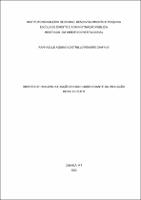Use este identificador para citar ou linkar para este item:
https://repositorio.idp.edu.br//handle/123456789/4288| Título: | Direito de imagem: atuação do judiciário diante da violação desse direito |
| Autor(es): | Gahyva, Raphaelle Aquino Castrillo Reiners |
| Orientador(es): | Gomes, Rodrigo Portela |
| Palavras-chave: | Direito de imagem;Violação de direito;Atuação do Judiciário |
| Data de submissão: | 2022 |
| Editor: | IDP |
| Citação: | GAHYVA, Raphaelle Aquino Castrillo Reiners. Direito de imagem: atuação do judiciário diante da violação desse direito. 2023. 84 f. Dissertação (Mestrado em Direito Constitucional). Instituto Brasileiro de Ensino, Desenvolvimento e Pesquisa, Brasília, 2022. |
| Resumo: | O Art. 5º, inciso X, da Constituição Federal de 1988, traz em sua redação sobre o direito de imagem, onde tem por função proteger a imagem de cada indivíduo. A problemática, nesse contexto, é referente à violação desse direito, o que, por consequência, gera a indenização, como uma das principais formas de resolução da questão. Em relação ao recurso metodológico utilizado, foi utilizada a pesquisa bibliográfica, a qual foi realizada com o amparo dos artigos científicos, livros, monografias e sites confiáveis que serviram como fonte de pesquisa. No que tange à observação da atuação do Poder Judiciário frente às violações ocorridas quanto ao direito de imagem, pode-se afirmar que, na maioria dos casos, a resolução dos conflitos ocorre, primeiramente, pela preservação do interesse público, bem como, posteriormente, pela utilização das disposições constitucionais, para em seguida, recorrer à interpretações infraconstitucionais específicas. Há, em síntese, portanto, como resultados obtidos dos julgamentos dos Tribunais superiores, em sua maioria, a aplicação da pena de indenização, por danos morais que podem englobar também danos materiais e estéticos a depender do caso, quando há situações em que houve a violação de dados sensíveis como a imagem, o nome e a privacidade. Nesse sentido, para finalizar, resta-se afirmar que todo e qualquer conflito precisa ser solucionado de maneira harmoniosa e à luz das normas vigentes, como forma de manter ao máximo possível os aspectos da justiça e da segurança jurídica. |
| Abstract: | Article 5, X, of the Federal Constitution of 1988, brings in its wording the right to the image, which has the function of protecting the image of each individual. It is emphasized that the problem, in this context, is related to the violation of this right, which, consequently, generates compensation, as one of the main ways of resolving this. Regarding the methodological resource used, bibliographical research was used, which was carried out with the support of scientific articles, books, monographs and reliable websites that served as a source of research. With regard to the observation of the Judiciary's performance in the face of violations regarding image rights, it can be said that, in most cases, the resolution of conflicts occurs, firstly, by preserving the public interest, as well as, later, by use of constitutional provisions, and then resort to specific infra-constitutional interpretations. There is, in summary, therefore, as results obtained from the judgments of the Superior Courts, in the majority, the application of the penalty of indemnity, for moral damages that can also include material and aesthetic damages depending on the case, when there are situations in which there was the violation of sensitive data such as image, name and privacy. In this sense, to conclude, it remains to be stated that any and all conflicts must be resolved in a harmonious manner and in light of current regulations, as a way of maintaining justice and legal certainty as much as possible. |
| URI: | https://repositorio.idp.edu.br//handle/123456789/4288 |
| Aparece nas coleções: | Mestrado Acadêmico em Direito Constitucional |
Arquivos associados a este item:
| Arquivo | Descrição | Tamanho | Formato | |
|---|---|---|---|---|
| DISSERTAÇÃO_RAPHAELLE AQUINO CASTRILLO REINERS GAHYVA.pdf | 566.04 kB | Adobe PDF |  Visualizar/Abrir |
Os itens no repositório estão protegidos por copyright, com todos os direitos reservados, salvo quando é indicado o contrário.
